 RN (1911): Active, Amphion, Fearless
RN (1911): Active, Amphion, FearlessWW1 RN Cruisers
Blake class | Edgar class | Powerful class | Diadem class | Cressy class | Drake class | Monmouth class | Devonshire class | Duke of Edinburgh class | Warrior class | Minotaur classIris class | Leander class | Mersey class | Marathon class | Apollo class | Astraea class | Eclipse class | Arrogant class | Highflyer class
Pearl class | Pelorus class | Gem class | Forward class | Boadicea class | Blonde class | Active class | Bristol class | Weymouth class | Chatham class | Birmingham class | Birkenhead class | Arethusa class | Caroline class | Calliope class | Cambrian class | Centaur class | Caledon class | Ceres class | Carlisle class | Danae class | Cavendish class | Emerald class
The last prewar scout cruisers: The Active class were three ships closely derived from previous Blonde/Boadicea scout cruisers. This third group only counted HMS Amphion and HMS Active, as HMS Fearless was built on similar plans a few months later. These three units were operational in 1913. With a few adjustments in armour, the main observable difference from previous classes were an arched bow of the new “breakwater” model. These ships also received extra AA 76mm guns during the war.
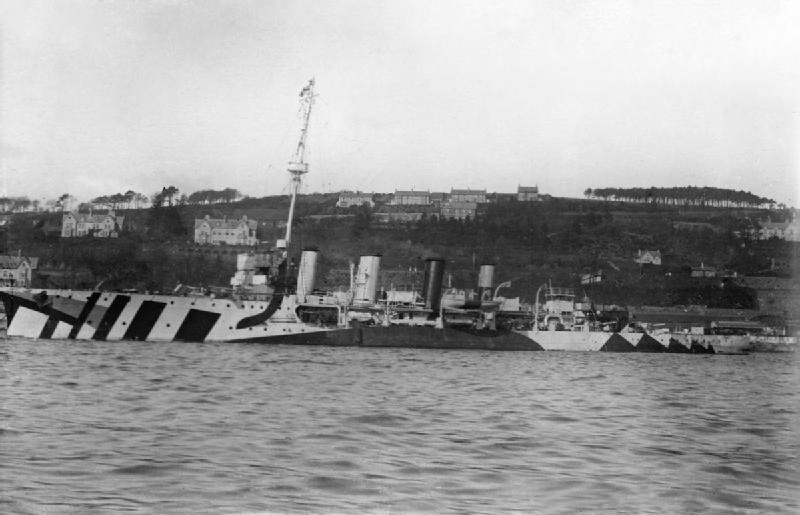
HMS Active, 1917
Development
The Active-class cruisers were three scout cruisers built for the Royal Navy, initially assigned to the 1st Fleet and acted as destroyer flotilla leaders in 1914. They were the last class of scout cruisers, since machinery tech made great leaps in between as well as the size and capabilities of destroyers. They were recognized as too slow to lead destroyers in battle or to defend the fleet against enemy destroyer attacks. Still, they were useful as fleet scouts alonsgide destroyers. HMS Active class was a slightly improved version of the Blonde class scouts. The major change was new “plough” bow adopted, which was tested and believed to improve seakeeping abilities. The first two were ordered under the 1910–1911 Naval Programme estimates, the last in the 19111-12 naval programme. They were completed shortly before the war, but had plenty of time to train already.
Design of the class
Hull and general design
The Active class were near-repeats of the Blonde/Boacidea design, Displacing a bit less at 3,340 long tons (3,390 t) versus 3,350 long tons with a reduced overall length of 405 feet (123.4 m), (versus 406 ft (123.7 m) and a slighty reduced beam of 41 feet (12.5 m) versus 41 ft 6 in (12.6 m), deep draught of 14 feet 6 inches (4.4 m) versus 15 ft 6 in (4.7 m). Designers tried to make them a bit more compact and lighter with the same machinery in order to reach greater speeds. They had the same output indeed. As for the general layout, they were a bit different, for the aforementioned “crescent” bow, still with a ram, unlike the more conventional ram bow of the Blonde class. They still had the same proportion for the forecastle compare to the aft deck, four equally spaced funnels amidships, a single mainmast, no aft mast, and their lighter guns and boats under davits all along the amidship section.
The artillery was the same, and the conning tower was separate from the bridge, built under it. This bridge comprised a fully enclosed navigation level and an upper, open observation bridge. Signalling apparatus were very important to communicate with nearby destroyers in formations, hence their tall foremast, composed of two parts, and the lower part supporting a lookout platform. Their crew consisted of 293 officers and ratings. The wireless cables were hanging from the upper section of the mast down to the aft deck directly i,nstead of a structure as on the Bonde class. There was a small aft strcuture supporting aft guns.
Powerplant
The Active class cruisers were different from the Blonde class in some minor ways. They powered by two sets of Parsons steam turbines, each driving two shafts (so 4 shafts total), which were able to deliver an output of 18,000 indicated horsepower (13,000 kW). Steam came from twelve Yarrow boilers burning both fuel oil and coal to be able to resupply about anywhere in the British Empire. Top speed was contracted at 25 knots (46 km/h; 29 mph), whereas most TBDs at the time were rated for 33-36 knots already. This was a bit better than the 24.5 knots (45.4 km/h; 28.2 mph) sported by the Blonde class. They also carried 855 long tons (869 t) coal in full load as well as 200 long tons (200 t) of fuel oil for a combined range of 4,630 nautical miles (8,570 km; 5,330 mi) at 10 knots (19 km/h; 12 mph) so a bit better again than the Blondes, capable of 4,100 nmi (7,600 km; 4,700 mi) at 10 knots (19 km/h; 12 mph). The slightly reduced hull and crescent bow made the trick, but this was unsufficient still.
Protection
Being scout cruisers, they had been wilfully lightly protected in order to preserve speed. The latter as seen very much as an “active protection”, making them too hard to spot and target accurately with the fire control systems of the time. They were a “light” version of protected cruisers, with a curved (turtleback) protective deck 1 inch (25 mm) thick on the slopes, down to 0.5 inches (13 mm) on the flat, central section for TB or destroyer shells to bounce off. Their conning tower was only protected against current destroyer gun shells of the time, with walls four inches thick. In addition they benefited from an intensive below waterline compartmentation, with as much as xxx bulkheaded compartrments filled with coal, added to the oil tanks. Oil was preferrable to slow an incoming round down due to its high density, viscous nature, it just absorbed any blast to some extent, and could not easily burn.
Armament
The main armament of the Active class repeated the Blonde scheme essentially. They had ten breech-loading (BL) 4-inch Mk VII guns as main armament. Their secondary armament comprised four quick-firing (QF) 3-pounder 1.9 in Vickers Mk I guns, and two submerged 18-inch (450 mm) torpedo tubes.
10x 4-inch Mk VII
The forward pair of guns were mounted side by side on a platform on the forecastle, six were amidships, three on each broadside, and the two remaining guns were on the centreline of the quarterdeck, one ahead of the other. The guns fired their 31-pound (14 kg) shells to a range of about 11,400 yards (10,400 m).
3-pdr Vickers Mk I
These 47-millimetre (1.9 in) Vickers Mk I were located on the aft structure and bridge’s wings.
Torpedo Tubes
The two submerged 18-inches TTs were fixed and located below the sloped armoured deck.
Wartime Modifications
In 1918, two 4-inch guns were removed from Active and Fearless.
A QF three-inch 20 cwt anti-aircraft gun was added to Active in 1916 but Fearless only receiving one by 1918.
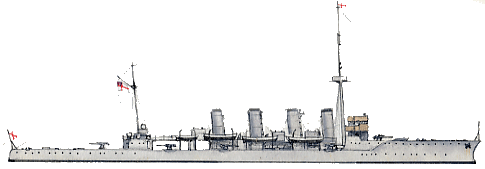
HMS Amphion illustration in august 1914.
Active class specifications |
|
| Dimensions | 405 x 41 ft x 14 ft 6 in (123.4 x 12.5 x 4.4 m) |
| Displacement | 3,340 long tons (3,390 t) normal |
| Crew | 293 |
| Propulsion | 4 shafts Parsons Steam Turbines, 12 Yarrow boilers, 18,000 shp (13,000 kW) |
| Speed | 25 knots (46 km/h; 29 mph) |
| Range | 4,630 nautical miles (8,570 km; 5,330 mi) at 10 knots (19 km/h; 12 mph) |
| Armament | 10× BL 4-inch (102 mm), 4× QF 3-pdr 47 mm, 2× 18-in (450 mm) TTs |
| Armor | Deck 0.5–1 in (13–25 mm), CT 4 in (102 mm) |
Evaluation of the class
These three cruisers were part of the last attempts to create cruisers acting as scouts and destroyer leaders for battleships lines. They were supposed to lead a sequadron of destroyer than would fan out in reconnaissance around the cruisers to report at short range by wireless or signals, smoke at the horizon. A fleet should always have at least two of three os such flotillas, each port and starboard and one forward, creating a wide reconnnaissance area in that pre-aviation era. But it was obvious in 1914 that the convept was flawed already. The Admiralty since 1913 already concluded destroyers being lighter than cruisers, would always make better flotilla leaders and created a whole lineage of such ships, which would later form the bedrock for early interwar designs. There were limits in the speeds than can achieve a cruiser, and having now a differential of almost ten knots in service with its destroyers was not about to cut it. Scouts already were being reorganized into packs of light cruisers working together rather than cruiser-destroyer-mixes, notably a second echelon in a deeper deployment while at sea.
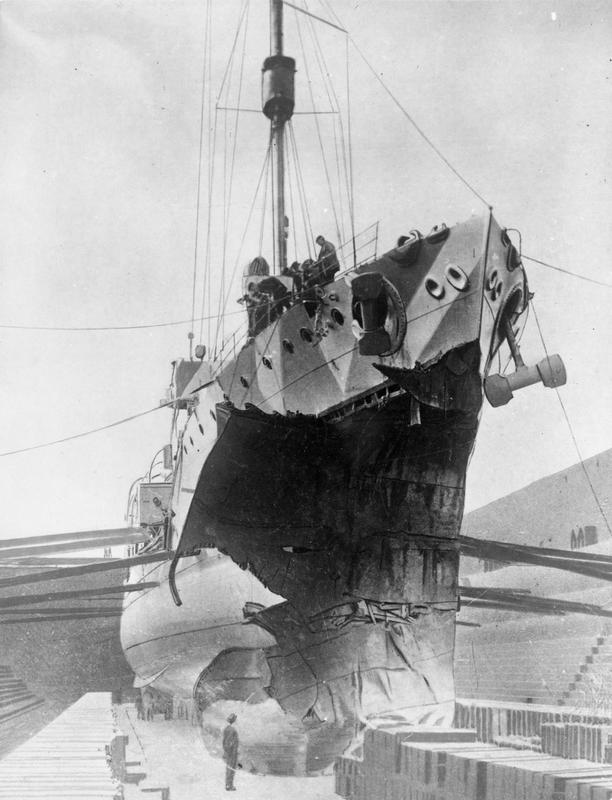
HMS Fearless after ramming and sinking a K class submarine at the “battle of May Island”.
The Active class in Action
The Active class were part of the 2nd destroyer flotilla, transferred to Harwich in 1914. Then, after a quick mission for the Grand Fleet. HMS Active joined the fleet division 4 in Portsmouth, and after 1917 in Queenstown, and after that was based in the Mediterranean. She was withdrawn from service in 1920 and later sold for scrap. HMS Amphion was assigned to the 3rd fleet Division in Harwich, engaged and later was sunk on August 6, 1914 by one or several of the mines laid by German auxiliary cruiser Königin Luise, becoming the first naval loss of the war.
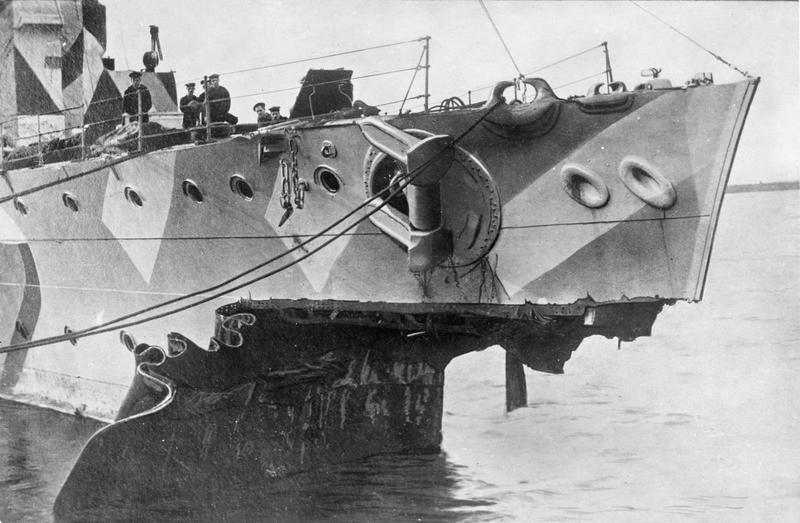
HMS Fearless served with the 1st Fleet division in Harwich before becoming leader of the 12th squadron of submarines, and finally served as flotilla leader for destroyers of the “K” class. She was took part in the Battle of May Island January 31, 1918, spurring the K17, and was withdrawn from service in 1921.
 HMS Active
HMS Active
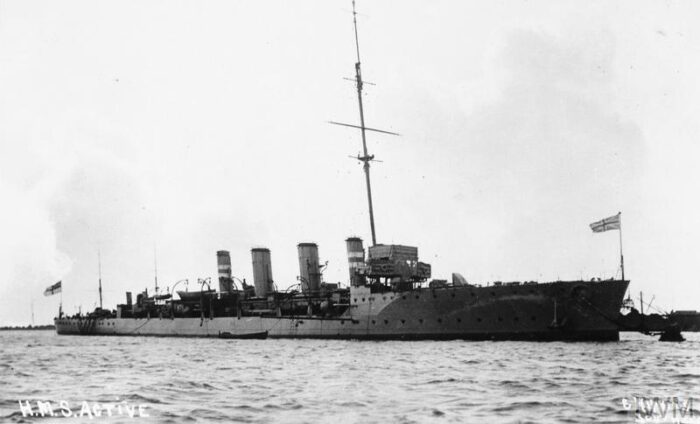
Ordered with the 1910 Naval Programme, 10th of her name she was laid down at Pembroke Dockyard’s No. 5 Slipway on 27 July 1910, launched on 14 March 1911, completed in December 1911, assigned to the 4th Battle Squadron, 1st Fleet on 18 February 1913, transferred to the 1st Light Cruiser Squadron on 18 June. She became flotilla leader, 2nd Destroyer Flotilla, 18 March 1914.
By August she was attached to the Grand Fleet and on 1 September, she was srnt to investigate a submarine reported inside Scapa Flow (false report). She escorted battleshis alternated with ASW patrols off Scapa Flow. By mid-October more submarines were reported in the Minch so Admiral Sir John Jellicoe send her to hunt them down, nothing being found. She was at Lough Swilly on 22 October until relieved of her assignment, detached with the Grand Fleet in January and attached to its flagship, HMS Iron Duke. She was in distant cover at the Battle of Jutland on 31 May, screening the left flank but when deploy to port she fell behind the battleships, still firing just eight 4-inch rounds at very long distance and missed.
Next she became leader of the 4th DF based at Immingham, Humber. On 18 August, she followed the Grand Fleet after a Room 40 report on a High Seas Fleet sortie to bombard Sunderland after recce by Zeppelins and submarines. The High Seas Fleet was never spotted. Active was then was assigned to the 6th DF, Dover Patrol, from January 1917. She did not fire a shot during the 25/25 February and 20/21 April night engagements. On January 1918 she was at Queenstown as flagship, Southern Division, Coast of Ireland Station. She was sent to the Mediterranean, based in Gibraltar in April, survived the war and still there on 1 December 1918, sent in reserve at Devonport from 1 February 1919, sold for BU on 21 April 1920.
 HMS Amphion
HMS Amphion
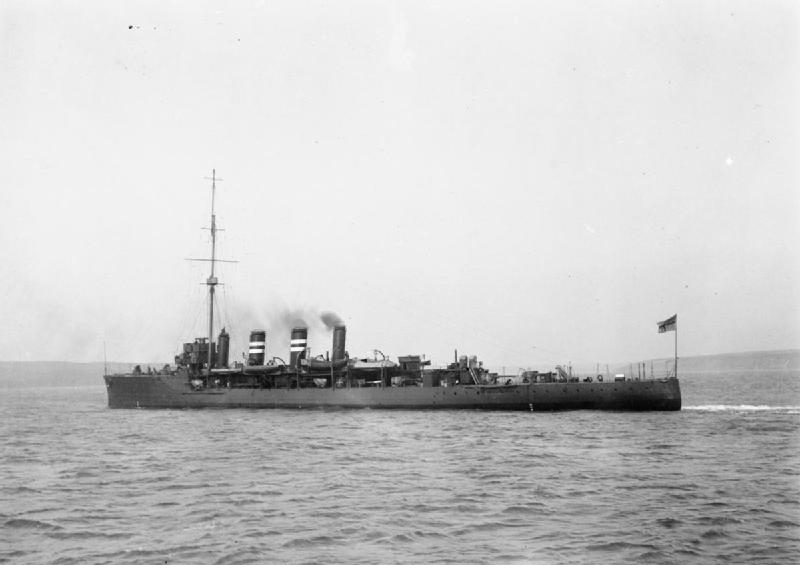
HMS Amphion in August 1914
HMS Amphion was ordered at part of the 1910 Naval Programme, laid down at Pembroke Dockyard on 15 March 1911, launchedon 4 December 1911 and completed by March 1913. Her first commander was Captain Frederic Dreyer, with Lieutenant John Tovey (yes, this one) as First Lieutenant (XO). She was assigned to the 4th Battle Squadron, 1st Fleet and a month later, 1st Light Cruiser Squadron, and as flotilla leader of the 3rd Destroyer Flotilla from 18 June 1914. On August, 1st, she was assigned to the Harwich Force, eastern approaches to the English Channel under Captain Cecil H. Fox. On 5 August she sortied into the North Sea for a patrol between Harwich and Terschelling. At 10:15 she spotted a ship apparently belonging to the Great Eastern Railway’s steamers close to the Hook of Holland. She order her destroyers Lance and Landrail forward to investigate, they crossed a trawler which reported a suspicious ship ‘throwing things overboard, presumably mines’. The flotilla went on the hunt, and caught up with the mysterious steamer, with HMS Lance opening fire at 10:45 from 4,400 yards (4,000 m). This was SMS Königin Luise, former Hamburg-Heligoland excursion boat reconverted as auxiliary minelayer for night undercover minelaying missions. They just had two 8.8-centimetre (3.5 in) defendive guns on board and had laid most of their 180 mines in the night of 4 August, off the Thames Estuary at dawn. Two, then three destroyers joined in but were so ineffective that Amphion closed in turn and open fire from 7,000 yards (6,400 m), scoring hits from 11:15. By noon, Königin Luise was sinking. 5 officers and 70 ratings were rescued. Upon reaching the Dutch coast around 21:00 the patrol ended and the flotilla went for home. Captain Fox was uncertain of where the mines laid by Königin Luise and closed 7 nautical miles (13 km; 8.1 mi) west of the supposed minefield.
In reality she went in the middle of it and at 06:35, compounded by the night, making spottings even harder, she hit a mine, detonated underneath her bridge. The whole forecastle erupted in flames as described by the destroyers aroound, and she apparently had her keel broken. HMS Linnet at first tried to tow her but soon the damage and cracking noise prompted captain Fix to abandon ship, and this process was ongoung when her forward magazine, heated up by the uncontrollable fire, exploded. A 4-inch was thrown into the air and some shells burst on the deck of the destroyer HMS Lark, killing 2 men. Amphion rapidly sank within 15 minutes afterwards, leaving 1 officer and 131 ratings going under, plus many men from Königin Luise. Her wreck was rediscovered and is now a protected site.
 HMS Fearless
HMS Fearless
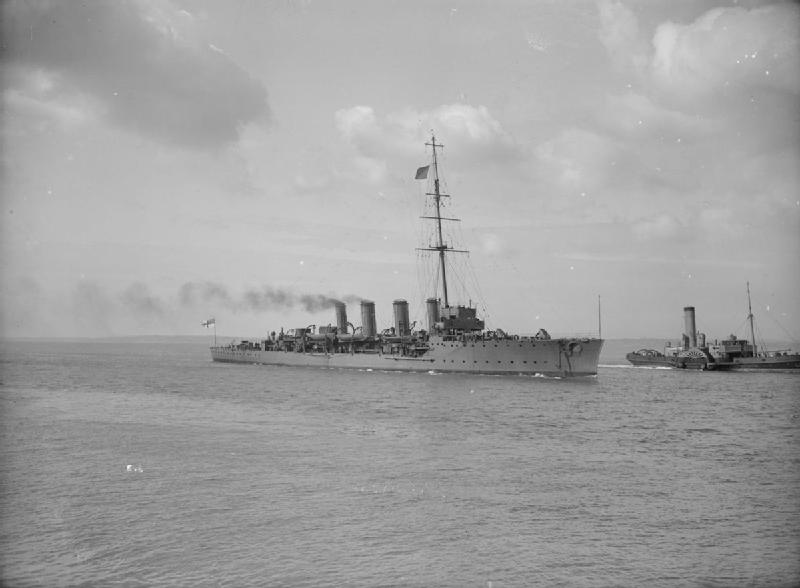
HMS Fearless in 1913
HMS Fearless was built at Pembroke Dockyard, laid down on 15 November 1911, launched on 12 June 1912 and commissioned by October 1913. She was assigned to the 1st LCS, leader of her own DF as of 18 July 1914, transferred, to the Harwich Force. On the morning of 4 August she was ordered by Commodore Reginald Tyrwhitt, Harwich Force, to lead the 1st and 3rd DF southeast of Borkum, Frisian Islands, Dutch coast to report a possible German sortie. Fearless flotilla saw nothing but the 3rd DF sank Königin Luise, which cost Amphion’s sinking afterwards as we just saw. On 17 August, the 1st DF were ion patrol when stumbling onto the light cruiser SMS Stralsund. Fearless’s lookouts misidentified her as an armoured cruiser so her captain to fall back, wait for assistance, when they realized the error it was too late and the cruiser was gone.
Next, she took part in the Battle of Heligoland Bight on 28 August. The two destroyer flotillas of the Harwich Force sotied that day for Heligoland, supported by a submarine flotilla and the 1st LCS, then the Grand Fleet battlecruisers in distant support. The 3rd DF damaged several torpedo boats and soon SMS Stettin at 08:00 was spotted and fired upon by Fearless over five minutes, she knocked one gun. Fog concealed the Germans. Turned west to disengage Fearless spotted and engaged SMS V187, which disengaged but fell on the 1st LCS and was sunk. Tyrwhitt on his flagship HMS Arethusa was almost sunk by SMS Frauenlob so Fearless was called for her, to cover her withdrawal. At 10:35, SMS Strassburg spotted Arethusa in turn, but was pushed back by Fearless and destroyers of the two flotillas. Cöln was also fired upon and disengaged.
Strassburg later returned at 11:10, fired on Arethusa and this time David Beatty’s battlecruisers turned south to assist. Fearless was far from her own destroyers in the confusion. Bu they were saved by the 1st LCS at 11:50. Mainz was hit but escaped, only to fell on Fearless and the rest of the Harwich Force. Fearless hit her rudder and pummelled her as she was now helplessely circling. She later engaged Cöln and Strassburg, later helped by the battlecruisers. Cöln and SMS Ariadne were sank. Fearless then headed for home with the crippled HMS Laertes in tow.
Zeppelin started to appear, so a RN raid was planned on Cuxhaven shelds. There was an attempt on 24 October (cancelled due to weather), on 23 November (cancelled, radio intercept). On 24 December, they were underway with HMS Fearless and eight destroyers from the 1st DF as close cover for the strike force of seaplane carriers, spotted at 07:30 on the 25th, launching seaplanes north of Heligoland. German seaplanes and a Zeppelin were on search for the British ships, another Zeppelin joined in and soon spotted the 1st DF. Fearles was attacked ineffectively by two seaplanes and a Zeppelin, but they were driven off, then later another attack.
After the Battle of Dogger Bank, raids by German battlecruisers prompted a reorganisaton of the Grand Fleet and Beatty’s Battlecruisers were permanently attached Fearless’s flotilla from 21 February 1915 from Rosyth, Scotland. On 9 March she was ordered at sea with nine destroyers for the reported U-12. She also covered minelaying missions in the southern North Sea on 10 September. At the occasion of the Battle of Jutland she screened the Battlecruiser Fleet on 31 May 1916, and was attached to the 5th Battle Squadron (BS) trailing the two battlecruiser squadrons. When turning north, the 1st DF fell in on the unengaged side and returned to screen the battlecruisers, leaving Fearless behind, too slow and back to the 20-knots capable 5th BS, later remainder of the Grand Fleet. She trailed the 1st Battle Squadron during the night and was asked to assists HMS Marlborough, torpedoed earlier by Vice-Admiral Cecil Burney and proceed to a flagship transfer on Revenge. Fearless escorted Marlborough home, engaging underway a Zeppelin on 1 June while Marlborough was near-missed by SM U-46. But the weather deteriorated and Marlborough was heavy and slow, so at 00:47 on 2 June, its captain warned Fearless and escorting destroyers they shound prepare to come and rescue her crew. But the pumps held until she arrived in the Humber. Fearless departed for South Queensferry, having only fired 3 4-inch rounds in the battle.
She was relocated to Belfast on 19 July 1916 fir a long refit and conversion into a submarine depot ship until 4 October. She was sent to Murmansk, Russia, arrived on the 19th for British G-class submarines there. She was back home on 15 November, twoing three submarines. By January 1917 she was leader of the 12th Submarine Flotilla, Grand Fleet, all K-class steam-powered submarines at Scapa Flow. After a refit on 3–17 March at Invergordon she saw little activiry and on 17 July, she was transferred to Rosyth. However on the evening of 31 January 1918, while in a training exercise with the 12th and 13th Submarine Flotillas sandwiched by squadrons of battlecruisers and battleships in poor visibility, accident happened on what became the infamous “battle of May Island”. At 19:14 on K lost her steering, fell out of the formation and was rammed by another sub. Cdr. William Leir (13th SF) decided to turn his flotilla around at 17:40 but crossed the path of the 12th SF. Fearless rammed and sank HMS K17. Captain Charles Little was moving too fast to avoid the submarine. He launched his boats buu found no survivors. Sailors tried to reinforc her bulkhead as she lost her low bow, and she managed to return to Rosyth, repaired, seeing little activity until the end of the war, sold for BU in November 1921.
Read More/Src
Books
Specs Conway’s all the world fighting ships 1921-1947.
Links
The Active class on wikipedia
On historyofwar.org
Videos

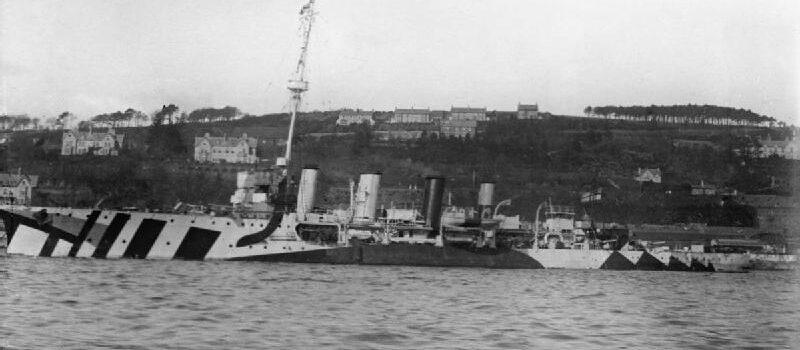
 Latest Facebook Entry -
Latest Facebook Entry -  X(Tweeter) Naval Encyclopedia's deck archive
X(Tweeter) Naval Encyclopedia's deck archive Instagram (@navalencyc)
Instagram (@navalencyc)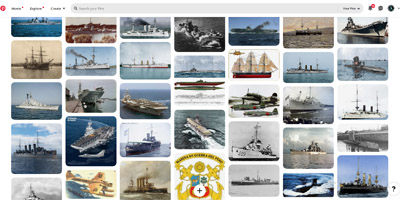


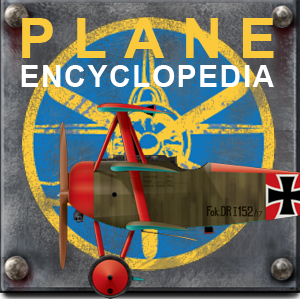
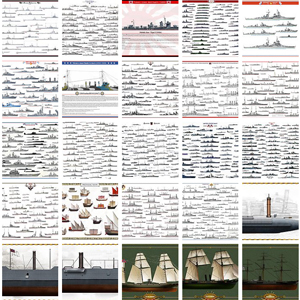
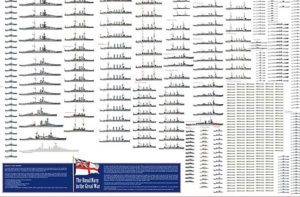
 French Navy
French Navy Royal Navy
Royal Navy Russian Navy
Russian Navy Armada Espanola
Armada Espanola Austrian Navy
Austrian Navy K.u.K. Kriegsmarine
K.u.K. Kriegsmarine Dansk Marine
Dansk Marine Nautiko Hellenon
Nautiko Hellenon Koninklije Marine 1870
Koninklije Marine 1870 Marinha do Brasil
Marinha do Brasil Osmanlı Donanması
Osmanlı Donanması Marina Do Peru
Marina Do Peru Marinha do Portugal
Marinha do Portugal Regia Marina 1870
Regia Marina 1870 Nihhon Kaigun 1870
Nihhon Kaigun 1870 Preußische Marine 1870
Preußische Marine 1870 Russkiy Flot 1870
Russkiy Flot 1870 Svenska marinen
Svenska marinen Søværnet
Søværnet Union Navy
Union Navy Confederate Navy
Confederate Navy Armada de Argentina
Armada de Argentina Imperial Chinese Navy
Imperial Chinese Navy Marinha do Portugal
Marinha do Portugal Mexico
Mexico Kaiserliche Marine
Kaiserliche Marine 1898 US Navy
1898 US Navy Sovietskiy Flot
Sovietskiy Flot Royal Canadian Navy
Royal Canadian Navy Royal Australian Navy
Royal Australian Navy RNZN Fleet
RNZN Fleet Chinese Navy 1937
Chinese Navy 1937 Kriegsmarine
Kriegsmarine Chilean Navy
Chilean Navy Danish Navy
Danish Navy Finnish Navy
Finnish Navy Hellenic Navy
Hellenic Navy Polish Navy
Polish Navy Romanian Navy
Romanian Navy Turkish Navy
Turkish Navy Royal Yugoslav Navy
Royal Yugoslav Navy Royal Thai Navy
Royal Thai Navy Minor Navies
Minor Navies Albania
Albania Austria
Austria Belgium
Belgium Columbia
Columbia Costa Rica
Costa Rica Cuba
Cuba Czechoslovakia
Czechoslovakia Dominican Republic
Dominican Republic Haiti
Haiti Hungary
Hungary Honduras
Honduras Estonia
Estonia Iceland
Iceland Eire
Eire Equador
Equador Iran
Iran Iraq
Iraq Latvia
Latvia Liberia
Liberia Lithuania
Lithuania Mandchukuo
Mandchukuo Morocco
Morocco Nicaragua
Nicaragua Persia
Persia San Salvador
San Salvador Sarawak
Sarawak Uruguay
Uruguay Venezuela
Venezuela Zanzibar
Zanzibar Warsaw Pact Navies
Warsaw Pact Navies Bulgaria
Bulgaria Hungary
Hungary

 Bundesmarine
Bundesmarine Dutch Navy
Dutch Navy Hellenic Navy
Hellenic Navy Marina Militare
Marina Militare Yugoslav Navy
Yugoslav Navy Chinese Navy
Chinese Navy Indian Navy
Indian Navy Indonesian Navy
Indonesian Navy JMSDF
JMSDF North Korean Navy
North Korean Navy Pakistani Navy
Pakistani Navy Philippines Navy
Philippines Navy ROKN
ROKN Rep. of Singapore Navy
Rep. of Singapore Navy Taiwanese Navy
Taiwanese Navy IDF Navy
IDF Navy Saudi Navy
Saudi Navy Royal New Zealand Navy
Royal New Zealand Navy Egyptian Navy
Egyptian Navy South African Navy
South African Navy






























 Ukrainian Navy
Ukrainian Navy dbodesign
dbodesign